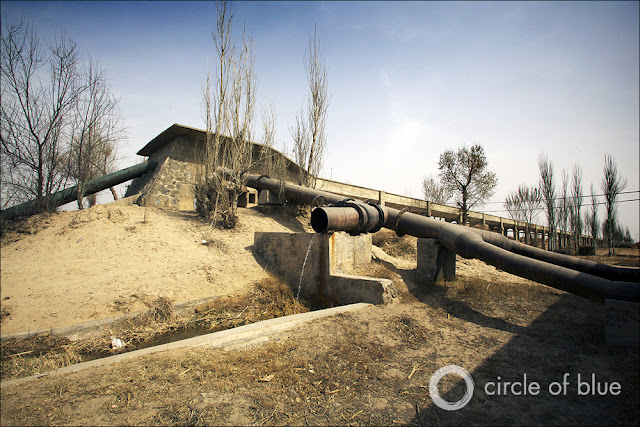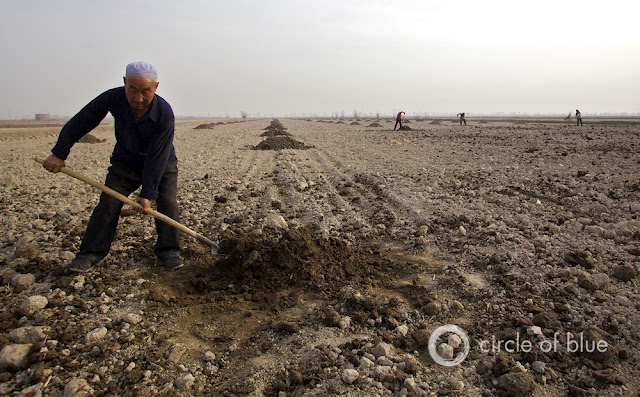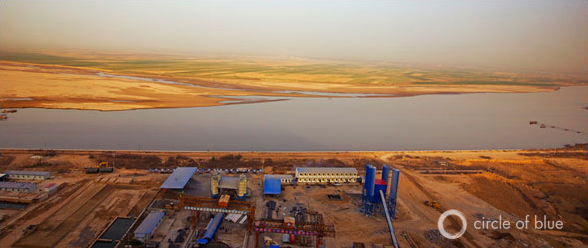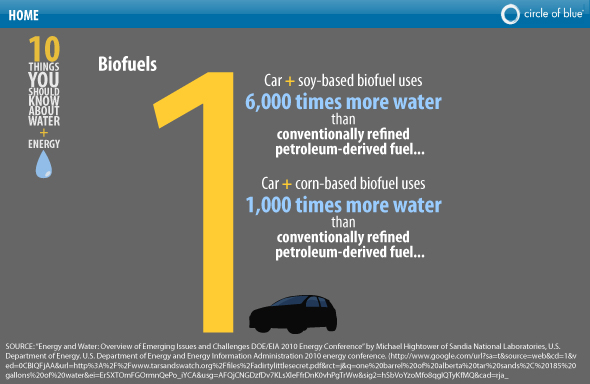Showing posts from category Choke Point.
-
Keith Schneider, Circle of Blue
Double Choke Point: Demand for Energy Tests Water Supply and Economic Stability in China and the U.S.
›The original version of this article, by Keith Schneider, appeared on Circle of Blue.
The coal mines of Inner Mongolia, China, and the oil and gas fields of the northern Great Plains in the United States are separated by 11,200 kilometers (7,000 miles) of ocean and 5,600 kilometers (3,500 miles) of land.
But, in form and function, the two fossil fuel development zones – the newest and largest in both nations – are illustrations of the escalating clash between energy demand and freshwater supplies that confront the stability of the world’s two biggest economies. How each nation responds will profoundly influence energy prices, food production, and economic security not only in their domestic markets, but also across the globe.
Both energy zones require enormous quantities of water – to mine, process, and use coal; to drill, fracture, and release oil and natural gas from deep layers of shale. Both zones also occur in some of the driest regions in China and the United States. And both zones reflect national priorities on fossil fuel production that are causing prodigious damage to the environment and putting enormous upward pressure on energy prices and inflation in China and the United States, say economists and scholars.
“To what degree is China taking into account the rising cost of energy as a factor in rising overall prices in their economy?” David Fridley said in an interview with Circle of Blue. Fridley is a staff scientist in the China Energy Group at Lawrence Berkeley National Laboratory in California. “What level of aggregate energy cost increases can China sustain before they tip over?”
“That’s where China’s next decade is heading – accommodating rising energy costs,” he added. “We’re already there in the United States. In 13 months, we’ll be fully in recession in this country; 9 percent of our GDP is energy costs. That’s higher than it’s been. When energy costs reach eight to nine percent of GDP, as they have in 2011, the economy is pushed into recession within a year.”
Continue reading on Circle of Blue.
Photo Credit: Used with permission, courtesy of J. Carl Ganter/Circle of Blue. In Ningxia Province, one of China’s largest coal producers, supplies of water to farmers have been cut 30 percent since 2008. -
Keith Schneider, Circle of Blue
China’s Other Looming Choke Point: Food Production
›The original version of this article, by Keith Schneider, appeared on Circle of Blue.
Even along the middle reaches of the Yellow River, which irrigates 402,000 hectares (993,000 acres) of farmland north of the Ningxia Hui Autonomous Region’s provincial capital, there is still no mistaking the smell of dry earth and diesel fuel, the abiding scents of a desert province that is also among China’s most efficient grain producers.
Ningxia farmers have relied on the Yellow River since 221 BCE, when Qin Dynasty engineers clawed narrow trenches from the sand, introducing some of the first instances of irrigated agriculture on earth. Despite persistent droughts, in each of the last five years irrigation has made it possible for annual harvests to increase by an average of 100,000 metric tons.
The 2010 harvest of 3.5 million metric tons was nearly double what it was in 1990. The 3.9 million people who live and work on Ningxia’s 1.2 million farms, most no larger than three-quarters of a hectare (1.6 acres), produce the highest yields of rice and corn in the nine-province Yellow River Basin, according to central government crop statistics.
In sum, the farm productivity of this small northern China region – about the same size as West Virginia and located 1,200 kilometers (745 miles) to the west of the Bohai Sea – reflects the major shifts in geography and cultivation practices over the last generation that have made China both self-sufficient in food production and the largest grain grower in the world.
Yet Chinese farm officials here and academic authorities in Beijing are becoming increasingly concerned that China does not have enough water, good land, and energy to sustain its agricultural prowess. As Circle of Blue and the Woodrow Wilson Center’s China Environment Forum have reported in the Choke Point: China series, momentous competing trends – rising energy demand, accelerating modernization, and diminishing freshwater resources – are putting the country’s energy production and security at risk.
The very same trends also threaten China’s farm productivity. Last year, the national farm sector and the coal sector combined used 85 percent of the 599 billion cubic meters (158 trillion gallons) of water used in China.
Continue reading on Circle of Blue.
Keith Schneider is the senior editor of Circle of Blue and was a New York Times national correspondent for over a decade, where he continues to report as a special writer on energy, real estate, business, and technology.
Photo Credit: Used with permission, courtesy of J. Carl Ganter/Circle of Blue. -
Choke Point China: Escalating Confrontation Between Water Scarcity and Energy Demand Has Global Implications
›The original version of this article, by J. Carl Ganter, appeared on The Huffington Post. Visit Circle of Blue for the latest articles in the Choke Point: China series.
Water scarcity, rapid economic growth, and soaring energy demand are forming a tightening noose that could choke off China’s modernization.
Writes my colleague Keith Schneider in the first installment of the new report, Choke Point: China, from Circle of Blue:Underlying China’s new standing in the world, like a tectonic fault line, is an increasingly fierce competition between energy and water that threatens to upend China’s progress. Simply put, say Chinese authorities and government reports, China’s demand for energy, particularly for coal, is outpacing its freshwater supply.
The 12-part Choke Point: China series presents powerful evidence of the fierce contest between growth, water, and fuel that is virtually certain to grow more dire over the next decade. The project is produced in partnership with the Woodrow Wilson International Center for Scholars’ China Environment Forum.
Tight supplies of fresh water are nothing new in a nation where 80 percent of the rainfall and snowmelt occurs in the south, while just 20 percent of the moisture occurs in the mostly desert regions of the north and west. What’s new is that China’s surging economic growth is prompting the expanding industrial sector, which consumes 70 percent of the nation’s energy, to call on the government to tap new energy supplies, particularly the enormous reserves of coal in the dry north.
The problem, scholars and government officials told us, is that there is not enough water to mine, process, and consume those reserves and still develop the modern cities and manufacturing centers that China envisions for the region. “Water shortage is the most important challenge to China right now, the biggest problem for future growth,” said Wang Yahua, deputy director of the Center for China Study at Tsinghua University in Beijing. “It’s a puzzle that the country has to solve.”
The consequences of diminishing water reserves and rising energy demand have been a special focus of our attention for more than a year. In 2010, in our “Choke Point: U.S.” series, Circle of Blue found that rising energy demand and diminishing freshwater reserves are two trends moving in opposing directions across America. Moreover, the speed and force of the confrontation is occurring in the places where growth is highest and water resources are under the most stress – California, the Southwest, the Rocky Mountain West, and the Southeast.
Stripped to its essence, China’s globally significant choke point is caused by three converging trends:- Production and consumption of coal – the largest industrial consumer of water – has tripled since 2000. Government analysts project that China’s energy companies will need to increase coal production by 30 percent by 2020.
- Fresh water needed for mining, processing, and consuming coal accounts for the largest share of China’s industrial water use, a fifth of all the water consumed nationally. Though national conservation policies have helped to limit increases, water consumption nevertheless has climbed to record highs.
- China’s total water resource, according to the National Bureau of Statistics, has dropped 13 percent since the start of the century. In other words China’s water supply is 350 billion cubic meters (93 trillion gallons) less than it was at the start of the century. That’s as much water lost to China each year as flows through the mouth of the Mississippi River in nine months. Chinese climatologists and hydrologists attribute much of the drop to climate change, which is disrupting patterns of rain and snowfall.
We found a powerful narrative in China in two parts, and never before told: First is how effectively the national and provincial governments enacted and enforced a range of water conservation and efficiency measures that enabled China to progress as far as it has.
Second is that despite the extensive efforts to conserve water, and to develop water-sipping alternatives like wind and solar energy, China still faces an enormous projected shortfall of water this decade to its energy-rich northern and western provinces. How government and industry leaders respond to this critical and unyielding choke point forms the central story line of the next era of China’s unfolding development.
J. Carl Ganter is director and co-founder of Circle of Blue, a leading source of news, science, and data about water issues globally. Choke Point: China is produced in partnership with the Wilson Center’s China Environment Forum.
Image Credit: Two tunnels beneath the Yellow River to be completed by mid-decade that will transport more than 35 million cubic meters (9 billion gallons) of water a day from southern China to thirsty cities in the north. Courtesy of Aaron Jaffe and Circle of Blue. -
Choke Point U.S.: Understanding the Tightening Conflict Between Energy and Water in the Era of Climate Change
›Without sharp changes in investment and direction, the United States’ current strategy to produce sufficient energy — including energy generated from clean sources — will lead to severe water shortages, and cause potentially major damage to the country’s environment and quality of life. These are the conclusions from a comprehensive reporting project, “Choke Point U.S.” presented by Circle of Blue at the Woodrow Wilson International Center for Scholars on Sept. 22, 2010.
At the event hosted by the China Environment Forum and Environmental Change and Security Program, J. Carl Ganter, Director of Circle of Blue, Keith Schneider, Circle of Blue’s senior editor, and Jeffrey J. Fulgham, Chief Sustainability Officer and Ecomagination leader at General Electric, discussed the findings of “Choke Point: U.S.,” an analysis of the tightening linkage between the nation’s rising energy demand and finite domestic freshwater supplies. The four-month Circle of Blue project explored whether the nation’s transition to a clean-energy economy will have net dividends or deficits for U.S. freshwater resources in an era of climate change, rising population, and a projected 40-percent rise in energy demand by 2050.
“In the next decade, every single sector will need to reform due to water shortage. This is not in fifty years, this is in the next decade,” Schneider told an audience of more than 70 energy and environmental experts from the research, policy, business, and security sectors.
As part of the project, Ganter said that Circle of Blue dispatched reporters to the coal fields of southern Virginia, the high plains of the Dakotas, California’s Central Valley, Midwestern farms, and other regions throughout North America. On one hand, their reporting revealed riveting narratives about the urgent contests between energy development and water supply, and how those contests can be resolved. On the other hand, the reports also recognized the extraordinarily difficult challenges that the energy-water nexus will pose to regional economies, governing practices, technological development, and the quality of natural resources.
Schneider, who directed the reporting, summarized the findings:- Unless the U.S. government plans more carefully, generating energy from clean alternatives is almost certain to consume much more water than the fossil fuels that green energy sources are meant to replace.
- The region confronting the energy-water choke point in the most dramatic fashion is the Southwest, where climate change is steadily diminishing snowmelt in the Rocky Mountains, and a prolonged drought is threatening to halt energy production at the Hoover Dam.
- The next era of hydrocarbon development is well underway in the United States, as energy companies invest billions of dollars a year to tap the “unconventional” oil sands of Canada, the oil shales of the northern Great Plains, and the gas shales of the Northeast, Texas, Oklahoma, and the Upper Midwest. However, tapping each of these carbon-rich reserves is using three to four times more water than the conventional oil and gas reserves they are replacing.
- Developers in North Dakota are spending roughly $7 billion annually to drill 1,000 wells a year now into the Bakken Shale. That effort will produce 100 million barrels of oil and 100 billion cubic feet of gas this year, but will use billions of gallons of North Dakota’s scarce groundwater.
- Each of the thousands of wells drilled each year into the unconventional gas shales underlying the Northeast, Gulf Coast states, the West, and Midwest requires three million to six million gallons of water injected under high pressure to fracture the rock and enable gas to flow out of the rock.
- In Kern County, California, where the agriculture and oil industries compete for diminished supplies of water for irrigation and energy production, the winner is the oil industry.
- The energy vector in the United States points strongly to more fossil fuel consumption, not less.
- All new energy technologies except wind and solar PV will require increased freshwater withdrawals.
From General Electric’s perspective, the next five to ten years will produce significant leaps in water technology that, if combined with efficient water use, appropriate valuation of water, and more holistic policies, will be key in avoiding an impending water Choke Point.
The speakers said that the trends identified in “Choke Point U.S.” could have serious implications not just for the United States, but also for freshwater supplies around the world. In August, Circle of Blue joined with the Wilson Center’s China Environment Forum to develop “Choke Point: China,” — a companion to the “Choke Point: U.S.” study — which will produce front-line research, reporting, and analysis about one of China’s most important resource competitions.
Peter Marsters is a Program Assistant with the China Environment Forum at the Woodrow Wilson Center.
Photo Credit: “Hoover Dam overlook,” courtesy of flickr user Creativity+ Timothy K Hamilton. -
Circle of Blue Launches ‘Choke Point: U.S.’ Series Examining Intersection of Water and Energy Resources
›Speaking yesterday at the Wilson Center, Circle of Blue Senior Editor and New York Times reporter Keith Schneider called his organization’s latest project, reporting on the intersection of finite water resources and growing demand for energy around the world, one of the most important stories of his career. First in the series is Choke Point: U.S.:
For as long as the United States has been a nation the central idea guiding energy development is to generate as much as the energy sector is capable of producing. In every way imaginable, though, the 21st century is testing the soundness of that principle. A number of environmental, economic, and political impediments lie in the path to large increases in American energy production.
For more check out Circle of Blue’s full feature as well their multimedia section, with infographics illustrating water regulations and power generation type by state, North Dakota’s remarkable rise to “domestic oil royalty,” and video interviews with residents and experts from around the country (including the Wilson Center’s Jennifer Turner, on China).
None, though, is more significant than the nation’s steadily diminishing reserve of fresh water. The place where rising energy demand collides with declining water supplies is a national choke point that the United States has barely begun to address, and certainly isn’t close to resolving.
Beyond the United States, Circle of Blue and the Wilson Center’s China Environment Forum also hope to start-up a “Choke Point: China” but are still seeking funding.
Image Credit: Graphic courtesy of Ball State University graduate student, Mark Townsend, and data compiled by Circle of Blue’s Aubrey Ann Parker and Andrea Hart.












